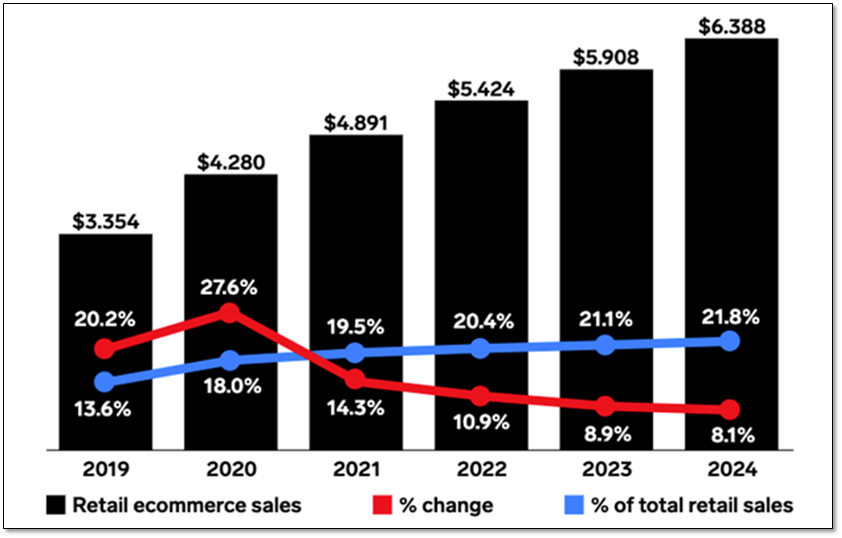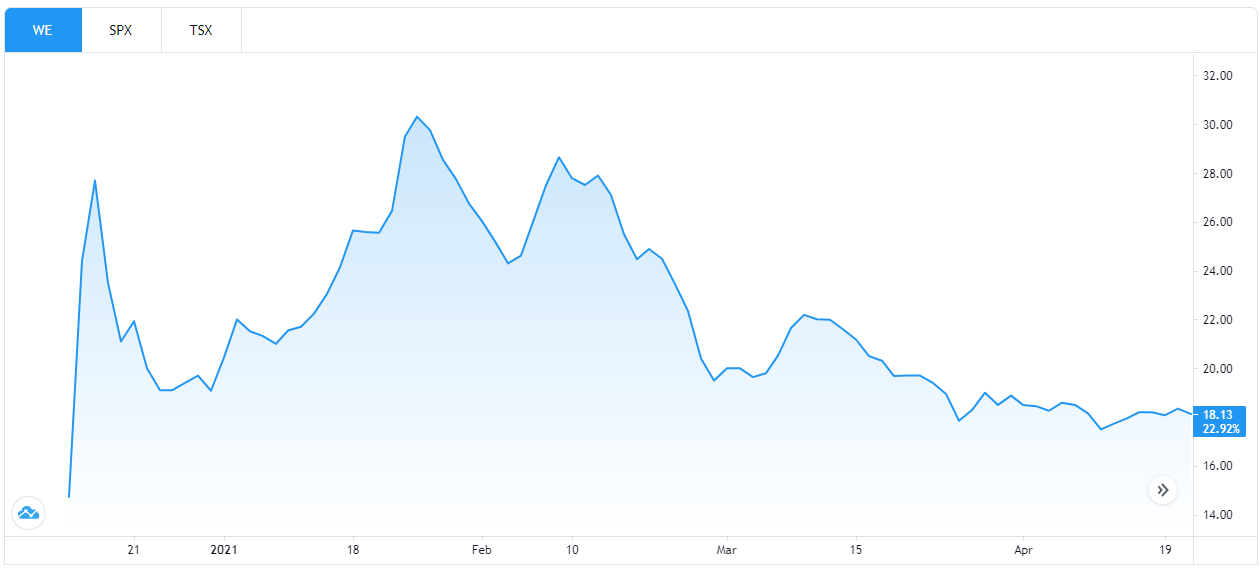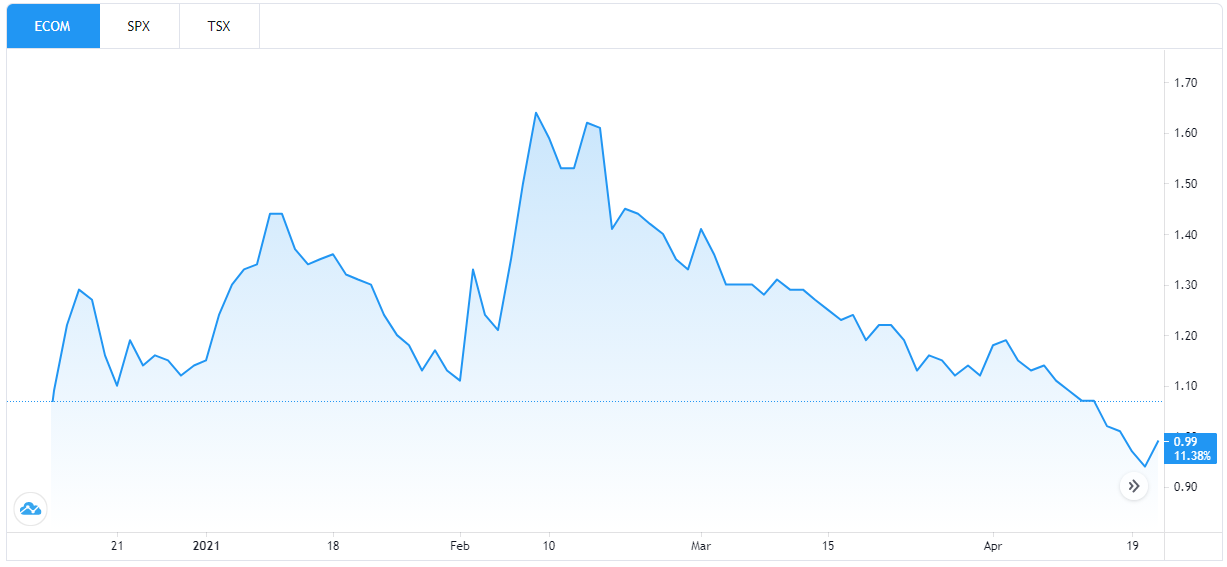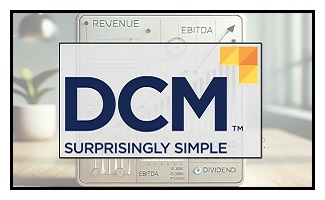In December 2020, WeCommerce (CSE:WE) and Emerge Commerce (CSE:ECOM) launched publicly and more recently, Vendasta filed for an Initial Public Offering (IPO) and is currently on the road trying to firm up the order book.
eCommerce Remains Hot
In a recent report by Insider Intelligence/eMarketer, eCommerce remains a rapidly growing industry with a projected a 14.3% growth rate for 2021 and sales reaching well over $4.89 trillion.
As COVID-19 restrictions keep some consumers at home, the eCommerce industry should continue experiencing solid growth in the near future. In addition, with a low barrier to entry to shift a business online, it should continue to capture a larger share of the total retail sales.
FIGURE 1: Retail Ecommerce Sales Worldwide, 2019-2024 ($ Trillions)

Each of the three companies focuses on a different aspect of eCommerce and have shown positive revenue growth but focus on slightly different business models.
1. WeCommerce
WeCommerce focuses on the Shopify universe by investing in or buying existing Shopify businesses and then using its expertise to grow the business.
However, when WeCommerce sees an overlooked opportunity, it moves quickly to start a new Shopify business to fill the niche.
In December 2020, WeCommerce and Brachium Capital Corp. completed a reverse takeover (RTO) and then raised C$60 million at $7.00 per share. However, interest in its business strategy garnered investors’ attention and the stock closed the first day of trading at C$14.75, giving it a Market Cap of approximate C$534 million.
FIGURE 2: WeCommerce Acquisition Strategy Overview

WeCommerce was incorporated in 2019, and recently reported 2020 revenue of C$21.3 million, up 40% year-over-year, with C$5.7 million in Cash Flow from Operations but posted a loss of C$4.4 million. With C$60 million of stock issued during the RTO process, WeCommerce should be able to execute on its “Strategic Acquisitions” strategy.
One risk for WeCommerce is that it is highly reliant on the Shopify eCommerce platform because the companies it chooses to acquire or develop are Shopify powered, and the platform is vital for revenue generation.
The benefit of WeCommerce’s business model is it can capitalize on many Main Street businesses ramping up their online presence to deal with the pandemic’s stay-at-home orders and customers making more web purchases for home delivery or curbside pickup.
According to an article by GuruFocus, they estimate by 2040, approximately 95% of retail transactions will be through eCommerce channels as opposed to brick-and-mortar stores. With Main Street businesses shifting to eCommerce, WeCommerce intends to use existing business models and build on top for more growth.
WeCommerce faces competition from companies with a larger market share, however, the growing eCommerce consumer base can potentially pose a positive outlook for WeCommerce’s success. As one of the first companies to partner with Shopify in the early 2010-2011 period, it presents itself ahead of the competition in terms of acquisition strategy with an understanding of the platform.
After hitting a peak of over $31, it’s currently trading at C$18.13, with a Market Cap of over C$672 million. The stock price is trending lower and trying to find the balance between revenue growth and stock market valuation. WeCommerce is covered by two analysts with a consensus Target Price of C$21.50.
FIGURE 3: WeCommerce Stock Chart since RTO

2. Emerge Commerce
Founded in 2016, Emerge aims to acquire and successfully operate numerous eCommerce-related assets, ranging from apps to Shopify stores.
In December 2020, Emerge and Aumento Capital VII Corporation completed an RTO and concurrently raised C$8.7 million at C$0.75 per share. The stock price closed the first day of trading above C$1.00 before peaking above C$1.70 in early February but now is trading in the C$1.00 to C$1.20 range.
Emerge primarily focuses on the small-to-mid-market eCommerce space and targets areas that could benefit from the consolidation of multiple assets or distressed eCommerce sites that could benefit from additional capital to reach their full potential.
Considering that Emerge is not solely dependent on one platform, such as Shopify, it has a lot of potential to grow its operations in multiple eCommerce streams for diversification.
In 2020, Emerge’s revenue reached C$9.2 million, up 121% from C$4.2 million in 2019, and showed a positive Adjusted EBTIDA of C$0.8 million, compared to a loss of C$0.6 million in 2019.
With a Market Cap of almost C$95 million, Emerge is currently trading at C$1.05 and 40% higher than the financing price during the RTO. Emerge is covered by two analysts with a consensus Target Price of C$2.25.
FIGURE 4: Emerge Commerce Stock Chart since RTO

3. Vendasta Files for an IPO
In March, Vendasta, a company focused on curating digital solutions for small and medium-sized businesses (SMBs), filed a C$100 million IPO.
Specializing in B2B solutions and software implementations, Vendasta creates a platform that enables customers to select and integrate digital solutions (CRM, Customer Support, eCommerce, etc.) from a network of channel partners.
Founded in 2008, Vendasta’s solutions can be integrated into many small businesses’ daily operations and enables SMBs to compete with larger competitors using similar digital tools.
Vendasta’s growth in registered SMB users could help spur it into profitability in the near future as it experienced a 200% user growth from 2019 to 2020 and 70% user growth from 2018 to 2019.
According to the filings, Vendasta revenues increased to C$42.6 million in 2020 from C$34.5 million in 2019. In 2020, it recorded a C$16.6 million loss from operations, more than double compared to 2019 but with a potential C$100 financing, the funds raised could support growth for six years.
For more information about Vendasta, please read our article on the IPO:
Notes: All numbers in USD unless otherwise stated. The author of this report, and employees, consultants, and family of eResearch may own stock positions in companies mentioned in this article. eResearch offers no representations or warranties that any of the information contained in this article is accurate or complete. Articles on eresearch.com are provided for general informational purposes only and do not constitute financial, investment, tax, legal, or accounting advice nor does it constitute an offer or solicitation to buy or sell any securities referred to. Individual circumstances and current events are critical to sound investment planning; anyone wishing to act on this information should consult with a financial advisor. The article may contain “forward-looking statements” within the meaning of applicable securities legislation. Forward-looking statements are based on the opinions and assumptions of the Company’s management as of the date made. They are inherently susceptible to uncertainty and other factors that could cause actual events/results to differ materially from these forward-looking statements. Additional risks and uncertainties, including those that the Company does not know about now or that it currently deems immaterial, may also adversely affect the Company’s business or any investment therein. Any projections given are principally intended for use as objectives and are not intended, and should not be taken, as assurances that the projected results will be obtained by the Company. The assumptions used may not prove to be accurate and a potential decline in the Company’s financial condition or results of operations may negatively impact the value of its securities. Please read eReserach’s full disclaimer.





